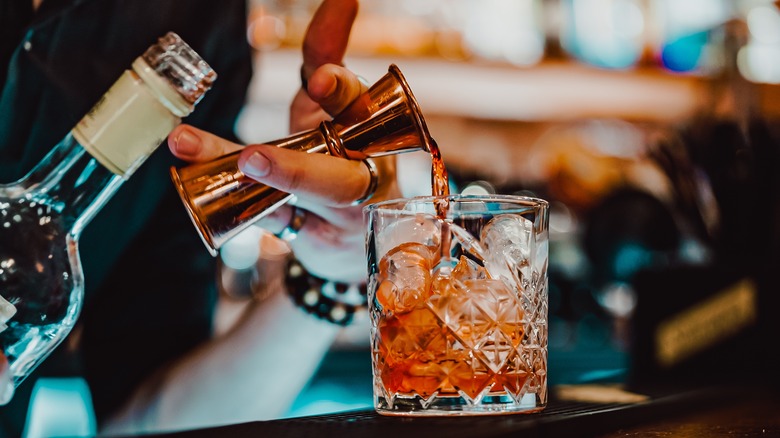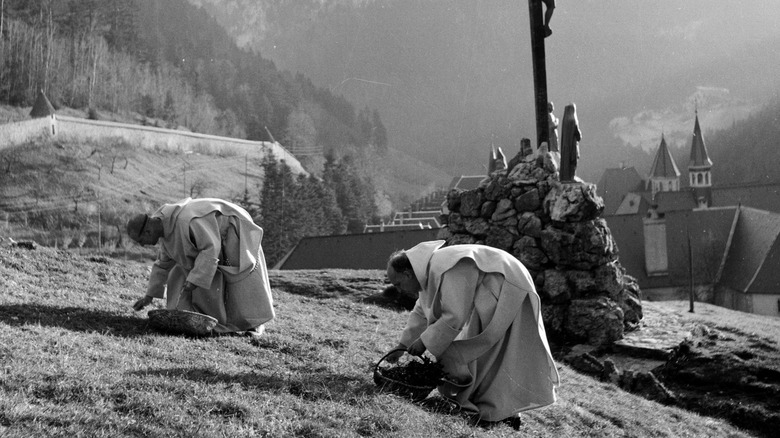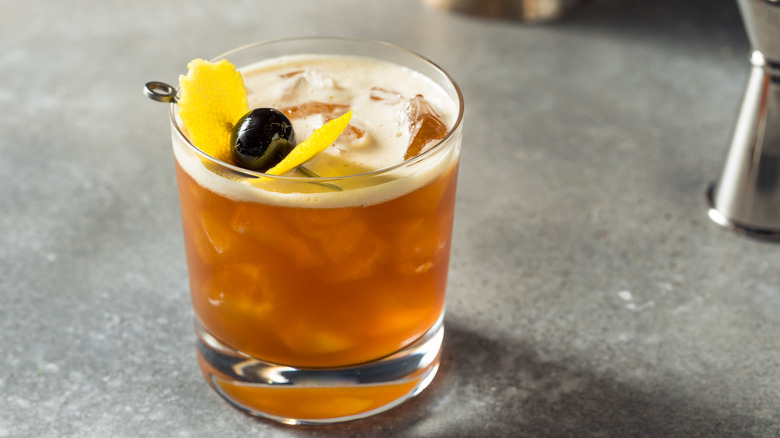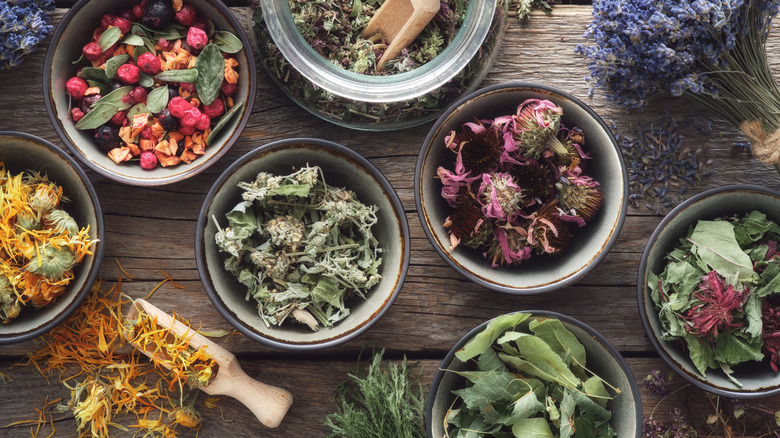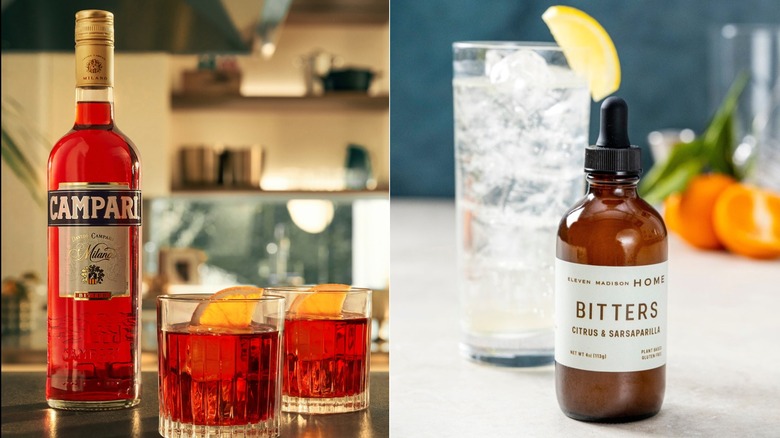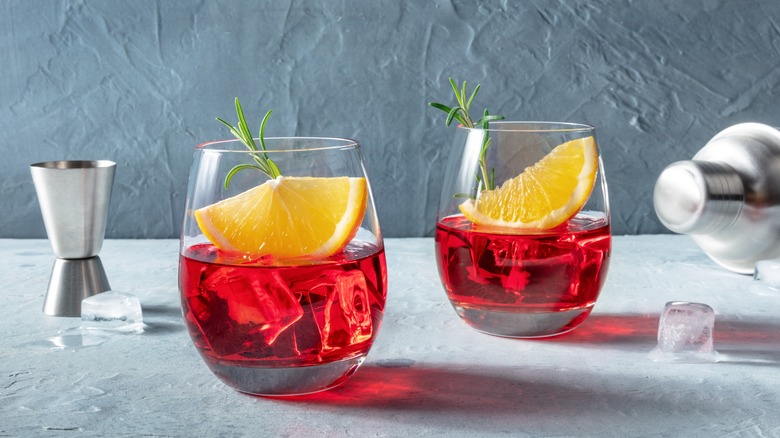What Exactly Is Amaro And How Do You Drink It?
When you hear the word amaro you probably think of the hottest cocktails of the moment that boast this spirit, whether it's a classic drink on the rocks or a light and trendy spritz. But what exactly is amaro?
Amaro is an Italian liqueur, but not just one type. It's actually an entire family of Italian liqueurs characterized by intense, bitter flavors — in fact, amaro is the Italian word for bitter. The complex flavors of different amari (the plural word for amaro) are built from blends of herbs, roots, flowers, bark, and citrus which are steeped in an alcoholic base such as brandy, and then aged. Two well-known amari are Aperol and Campari — though be sure to know the difference between the two. The alcohol content can vary quite drastically between varieties, ranging anywhere from 15% to 45% alcohol by volume.
Amari are part of a class of drinks called digestivos that are sipped after dinner to help settle a full belly. Amari are sometimes enjoyed as aperitivos, too, consumed just before a meal to encourage better digestion. While they may be trendy now, these herbal concoctions are nothing new; they've actually been around for ages.
A liqueur with thousands of years of history
Herb-infused liqueurs have been highly prized across Europe for centuries and were originally created as medicinal tonics; some examples are the German kräuterlikör and absinthe from Switzerland. Amaro hails from Italy; it's been a part of the culture there for so long that, according to Atlas Obscura, one variety can trace its origins back to ninth-century Benedictine monks. According to legend, the inspiration for the Tuscan amaro di Sant'Antimo came after a visit from an angel who showed the monks a wildflower that would become the key ingredient of the amaro. The monks believed the herbal liqueur could cure diseases such as the plague.
According to Liquor, Amari began to be commercially bottled and distributed in the 1800s, and each producer had their own, closely guarded recipes of herbs, botanicals, colorings, and flavorings. The spirits were touted for their health, restorative, and digestive benefits, and it became an Italian tradition to enjoy amari as a pre- or post-meal drink.
American interest in amari and amari-based cocktails over the last decade means that more varieties than ever before are now available on this side of the pond.
What does amaro taste like?
Broadly speaking, amari are known for being fairly bitter and dry. And because they're made with any number of botanicals like citrus peel, herbs, licorice, vegetables like rhubarb or artichoke, flowers, and roots, there is a big punch of herbal, even medicinal flavor along with that bitterness. That's why amari can be an acquired taste.
But of course, there are many, many types of amari available, each distinct thanks to their proprietary concoction of ingredients. For example, Amaro dell'Erborista is one of the most bitter amari but also has flavors of fruit and honey. Fernet-Branca has a strong taste of licorice and eucalyptus. On the lighter side of the amari spectrum, Averna has a light, citrusy flavor, and less bitterness. The sweeter Amaro Nonino is made with grappa wine. And these few varieties only scratch the surface of all the possibilities.
While you can rely on any amaro to be a distinctive spirit with flavors that will not go unnoticed, the vast number of amari available means that you really have to do some taste-testing to find your favorites.
How is amaro made?
The way amaro is created is a bit of an oxymoron: simple and yet also complex. It's simple because it's merely a matter of adding botanicals and other flavorings to alcohol and then letting the mixture age. However, it's complex because it's the precise combination and number of ingredients, and the balance of flavors that make each amaro so unique.
The list of possible ingredients used to flavor amari includes herbs, flowers, mushrooms, tree sap, artichokes, Chinese rhubarb, citrus and other fruits, licorice, and saffron. Ingredients like gentian, bitter oranges, and wormwood impart bitterness to amari, and then sugar or other sweeteners like honey are added to strike a balance. The base can be neutral alcohol, brandy, or other spirits such as grappa and Moscato. Barrel-aging also contributes to the flavor of each amaro.
Unlike some European foods and drinks, amaro has no protected designation with rules or requirements about how authentic amaro should be made. This means that amaro is and has been created in countless formulations, reflecting the terroir and ingredients of the regions where they're enjoyed.
What's the difference between amaro and bitters?
Amaro is made by steeping a blend of botanical and bitter ingredients into an alcohol base, and then aging the mixture. Bitters, which are sold in small bottles from brands like Angostura and Peychaud's are made by — steeping botanical and bitter ingredients in an alcoholic base and aging the mixture! So if these two things are made essentially the same way, and both have herbal and bitter flavors, what's the difference?
The biggest distinction is in the way that they are used. Amari are sometimes referred to as potable bitters, because even though they have a strikingly intense flavor, they're intended to be sipped on their own as a digestivo, or used as a star ingredient in a mixed drink. Aromatic or cocktail bitters, on the other hand, are meant to be used as a flavor boost one drop at a time; that's why the bottles have a little dropper top. Bitters are so concentrated and biting, paired with high alcohol content (35% to 45%,) that only the toughest of palates and stomachs can tolerate bitters in a larger quantity on their own.
There is, however, a gray area. Some amari, such as Amaro dell'Erborista produced in southern Italy, are known and beloved for their overly intense bitterness. And some have high alcohol content, like Milan's Fernet-Branca with a 40% ABV. As for cocktail bitters, there are indeed those who like to drink them over ice, with soda, or as a shot. It just proves that for diehard fans of bitter, herbal liqueurs, the rules on how to enjoy them are easy to throw out the window.
How to drink amaro
The ways to enjoy these bitter liqueurs are as varied as the different amari themselves. To really experience the unique flavor notes of your amaro, try it the authentic, Italian way: served neat or on the rocks. Some amari are served ice-cold from the freezer, which gives them a smoother, creamier texture and slightly mutes the flavors, making the intensity a little more palatable to those who find the bitterness too much to take.
However, where amari have really become trendy is in cocktails and spritzes. Aperol is an orangey-pink amaro that's the star of the pretty Aperol spritz, and since the alcohol content is low (around 11%) it makes a refreshing, summery drink. Negronis have had lots of press in recent years as a favorite cocktail of Anthony Bourdain and for the variation that went viral thanks to actor Emma D'Arcy: the negroni sbagliato made with sparkling wine. The star amaro for a negroni is Campari, which has a bright red hue, orange flavor, and an alcohol content double that of Aperol.
And those who like to get playful with their mixology can use amari in place of other spirits to make exciting, herbal variations of classic cocktails like a margarita, old fashioned, or Manhattan.
Amari to try right now
So how do you begin when there are so many kinds out there? Here are some authentic Italian amari brands to get curious imbibers started: each with its own unique characteristics.
Bologna's Amaro Montenegro has orange and floral flavors and is on the lower side of alcohol strength with a 23% ABV. You could also try Braulio from the Lombardy region. This amaro, while easy to sip, has a stronger flavor with notes of herbs, menthol, and evergreen trees.
For those who are really hesitant about the well-known bitterness of these liqueurs, Aperol is often considered a gateway amaro; the orange-flavored liqueur from Padua is on the sweeter side and has an ABV of just 11%. Campari is also a familiar amaro in the United States as the crimson red liqueur that stars in negronis. It's a more bitter amaro with an ABV of as much as 28%.
Finally, for the more adventurous palate who wants to try a really bold amaro, try Milan's Fernet-Branca. There are many types of fernet-style amari, but the Fernet-Branca brand is particularly brash, with a lot of bitterness and flavors of licorice, herbs, and ginger. It also has a high ABV of 40%. Another intense amaro worth trying is Northern Italy's Amaro Sfumato, made with Chinese rhubarb, berries, and herbs. It has a smoky, woody flavor with an ABV of about 20%
Once you've had your fill of trendy amaro drinks, why not explore the vast spectrum of Italian amari that extends way beyond Aperol spritzes? With hundreds of age-old varieties to try, the exploration into these herbal, bitter Italian liqueurs will delight adventurous sippers for years.
